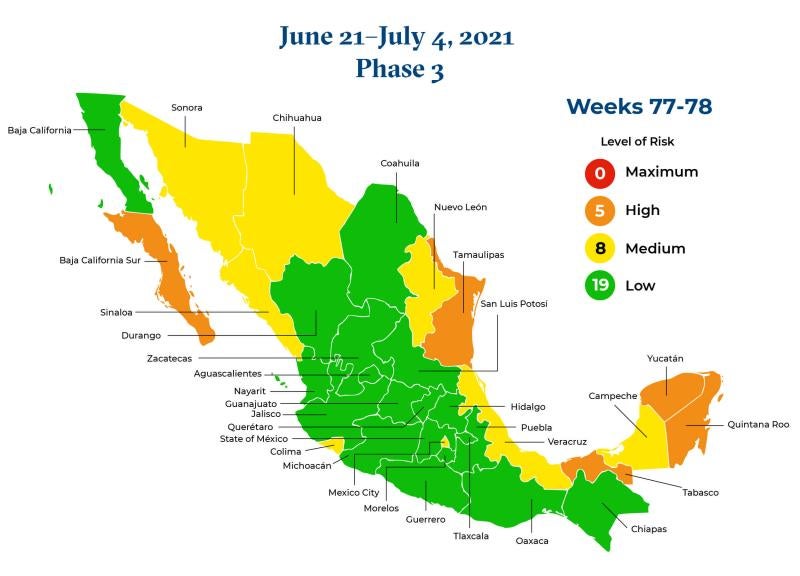The COVID-19 pandemic has continued to abate in Mexico, and as conditions have improved, the federal government has gradually eased COVID-19–related restrictions and lifted them entirely in 19 of the nation’s 32 states in accordance with the biweekly four-tiered traffic light epidemiological monitoring system.
The federal government recently designated 19 states in green status (indicating a full return to normal activities) for the June 7–20, 2021, report, thus making the four weeks encompassing the current report a notable period for the country since the government first implemented the system in June 2020. In the previous report, nine states were in yellow status, the second-least restrictive tier. One of those states, Tamaulipas, has recently been redesignated in orange status, one tier below red status (under which only essential activities are permitted), while other states have recently reported increases in their daily case averages. No state has been in red status since March 2021.
The monitoring system is used to alert residents to the epidemiological risks of COVID-19 and provide guidance on restrictions on certain activities in each of the country’s states. Below is a map for the period of June 21, 2021, through July 4, 2021, indicating the COVID-19 risk level in each of the states and the capital.

This chart presents the traffic light status of each state, and, as applicable, variations between federal and local traffic light statuses based on publications of the federal Ministry of Health and status reports provided by each state. The states are not obligated to follow the federal designation, and therefore may apply different restrictive levels. For example, the federal government has upgraded Baja California to green status, but the state government has kept the Mexicali municipality in yellow status.
More residents of Mexico are getting vaccinated, although there is still far to go. As of June 21, 2021, 40,700,954 doses—accounting for both the single- and double-dose vaccines—had been applied. As of June 25, 2021, approximately 14 percent of Mexico’s population had been fully vaccinated; approximately 22 percent had been partially vaccinated. Hospital bed occupancy rates—one of the criteria used to determine a state’s status—are continuing to drop, with 84 percent of general beds, and 86 percent of ventilator beds available. That is a significant improvement from February 2021, when only 59 percent of general beds were available and 60 percent of ventilator beds were available.
Health authorities in states such as Jalisco and Tamaulipas recommend that persons 60 years of age and older who have received a complete vaccination schedule and/or a single dose—depending on the vaccine applied—may return to work after 15 days have passed since the date of application of the last dose. Health authorities have also cleared pregnant women who are not on maternity leave to return to work at their workplaces. The federal government has not indicated when vulnerable people who have been fully vaccinated may return to their workplaces.
Mexico City Returns to Yellow Status
The Monitoring Committee of Mexico City has determined that the capital is in yellow status, downgraded from green status in the previous report. Under Mexico City guidance, at yellow status educational, social, cultural, and religious activities may continue to operate with no more than 60 percent of capacity. The Mexico City Monitoring Committee did not indicate the percentage of capacity allowed with the return to the yellow traffic light status for private corporate offices in the capital. Due to a lack of specific guidance from the committee, employers may want to consider following federal government guidelines, such as limiting workplace occupancy to 50 percent, complying with sanitary measures, and conducting, on a weekly basis, rapid antigen tests or reverse transcription–polymerase chain reaction (RT-PCR) tests of at least 20 percent of the personnel working on-site for the detection of the SARS-CoV-2 virus.
As noted in the June 7–20, 2021, report, Mexico City’s Administrative Verification Institute and other Mexico City governmental authorities will continue to visit workplaces to confirm that employers are complying with the general and specific sanitary measures for health protection. In the case of noncompliance with such measures, authorities may levy fines and/or order the total or partial temporary suspension of the work center for up to 15 calendar days.




 />i
/>i

